Can you believe this is the last issue of T. I. Life for 2017? Let’s hope for a long and enjoyable River season next year!
This month the Sudoku Puzzle #32 offers you a chance to crack a difficult puzzle. So please print the puzzle or copy it on your grid to give it a go, or follow along with me as we solve the puzzle.
|
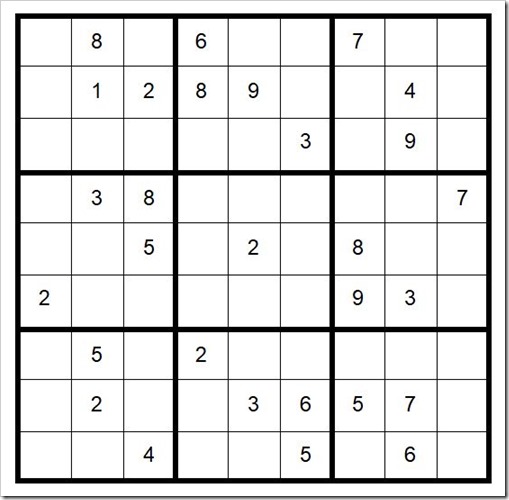
PUZZLE #32
|
|
DAN’S 8 STEP APPROACH TO SOLVING ALL SUDOKU PUZZLES
Once you have completed the puzzle, to the extent that you have filled in all obvious answers and have written all potential options across the top of the unsolved cells (PUZZLE PREPARATION), Dan recommends the following Steps to complete the puzzle.
See TI Life Puzzle Preparation: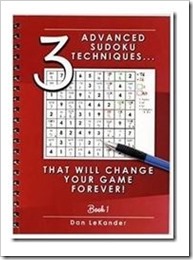
Step 1: Sudoku Pairs, Triplets and Quads – September 2015
Step 2: Turbos & Interaction – October 2015
Step 3: Sudoku Gordonian Rectangles and Polygons – November 2015
Step 4: XY-Wings & XYZ Wings – December 2015
Step 5: X-Wings – January 2016
________________
Step 6: DAN’S YES/NO CHALLENGE
Step 7: DAN’S CLOSE RELATIONSHIP CHALLENGE
Step 8: AN EXPANSION OF STEP 7
Steps 1-5 are relatively common techniques and are explained in the TI LIFE articles per above. Steps 6-8 are covered in detail, in Dan’s book.
Also, see Sudoku Puzzle Challenge… February 2016, March 2016, April 2016, May 2016, June 2016, July 2016, August 2016, September 2016, October 2016, November 2016, December 2016, January 2017, February 2017, March 2017 , April 2017, May 2017, June 2017, July 2017, August 2017, September 2017, October 2017 and November 2017.
As a reminder, the basic rules of Sudoku are that the numbers 1-9 must be contained and cannot be repeated in a row, column, or box, and there can only be one solution to the puzzle.
|
PUZZLE PREPARATION
Prior to utilizing techniques first complete the 4 Steps of Puzzle Preparation …
FILL IN OBVIOUS ANSWERS
FILL IN NOT-SO-OBVIOUS ANSWERS
MARK UNSOLVED CELLS WITH OPTIONS THAT CANNOT EXIST IN THOSE CELLS
FILL IN THE OPTIONS FOR THE UNSOLVED CELLS
OBVIOUS ANSWERS …
Start with the 1’s to see if there are any obvious 1-choice answers. Then navigate the 2’s through 9’s.
The first obvious answer is C6R1=2 (cell in column 6, row 1). C4R5=3. C9R3=8. C8R7=8. C5R9=8. C1R8=8. C6R6=8. C7R3=2. C8R4=2. C9R9=2. C9R6=5. C8R1=5. C8R5=1. C9R1=1.
NOT-SO-OBVIOUS ANSWERS …
In box 2 (upper center grid of 3X3 cells) a 5 can only exist in C4R3 or C5R3; therefore a 5 cannot exist in C1R3, C2R3 or C3R3. The only cell left in box 1 that can be a 5 is C1R2. C1R2=5.
In box 1 a 7 can only exist in C1R3, C2R3 or C3R3; therefore a 7 cannot exist in C4R3 & C5R3. The only cell left in box 2 that can be a 7 is C6R2. C6R2=7.
In box 2 a 1 & 5 cannot exist in C5R1; therefore, the options for cells C4R3 & C5R3 must be 1 & 5. With that in mind, the only choice for C5R1 is a 4. C5R1=4.
NUMBERS IN CELLS THAT CANNOT EXIST …
In box 5 a 7 can only exist in C4R6 or C5R6; therefore a 7 cannot exist in C2R6 or C3R6. Put a small 7 in the bottom of those two cells to indicate they cannot be a 7, in preparation for filling in the options for the unsolved cells. Now your grid should look like Example #32.1 below:
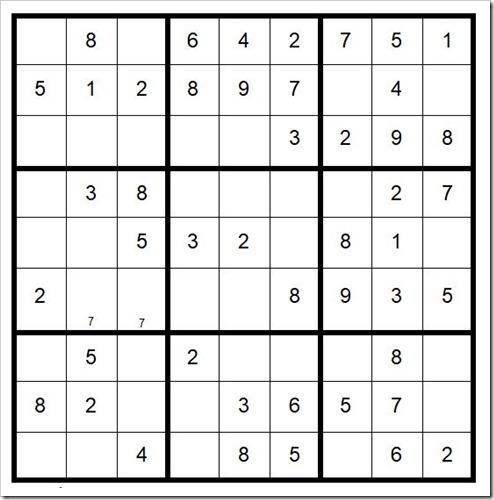
Example #32.1
|
FILL IN THE OPTIONS FOR THE UNSOLVED CELLS …
Now your grid should look like Example #32.2 below:
|
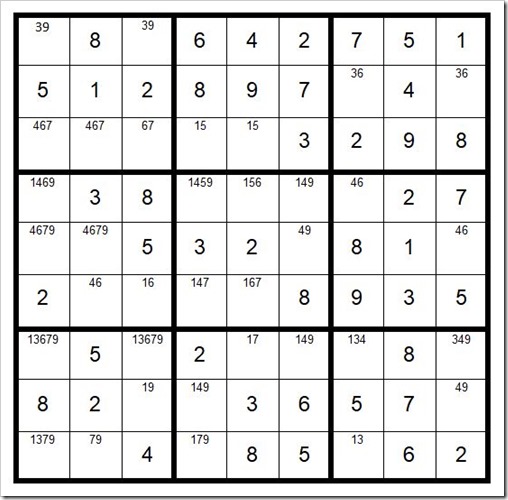
Example #32.2
|
STEPS 1-8 …
There are no Step 1-5 clues, so we will proceed with Step 6.
STEP 6: DAN’S YES-NO CHALLENGE
There are 3 circumstances that establish the potential for a Step 6 exercise:
Look for just 2 unsolved cells in a box that contain the same option where these 2 cells are not in the same row or column.
Look for just 2 unsolved cells in a column that contain the same option where these 2 cells are not in the same box.
Look for just 2 unsolved cells in a row that contain the same option where these 2 cells are not in the same box.
In column 6 we find just 2 unsolved cells that contain the number 1 as an option … C6R4 & C6R7. These cells are not in the same box, thereby qualifying as a candidate for a Step 6 exercise. These cells are highlighted below in Example #32.3 below:
|
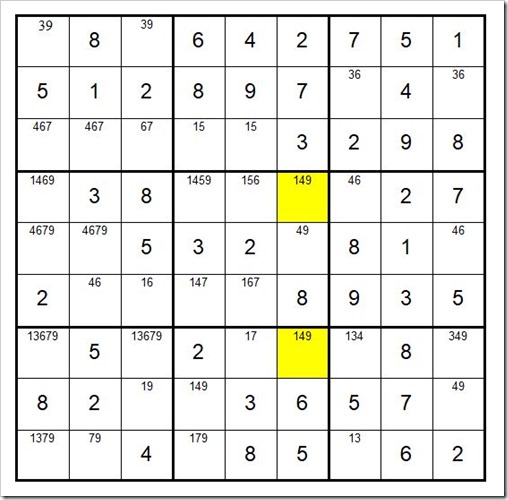
Example #32.3
|
One of these two yellow cells must be a 1. We will consider them as “driver cells” which “drive” the exercise.
Here is the logic. We will perform two exercises. First, we will assume C6R4 is the 1, and see which other cells cannot be a 1. Then we will assume C6R7 is the 1, and see which other cells cannot be a 1. What happens if we find a cell or cells that cannot be a 1 regardless of which cell in column 6 is a 1? Quite simply it means that that cell cannot be a 1 and you can eliminate the 1 from that cell or those cells.
We will mark C6R4 with a “Y” and mark C6R7 with a lower case “y” to keep track of the exercise as per Example #32.4 below.
If C6R4=1 (marked with a Y), then C1R4 cannot be a 1 and we mark it below with a “N” for no. The only other cell in box 4 that can now be a 1 is C3R6, which we mark as a Y. Then C3R7=N & C3R8=N.
If C6R7=1(marked as a y), then C1R7 & C3R7 are not a 1 and we mark them with a n.
Now look at C3R7 with its “N,n” designation. It is not a 1 regardless of which yellow cell is a 1. Therefore, you can remove a 1 as an option from C3R7.
|
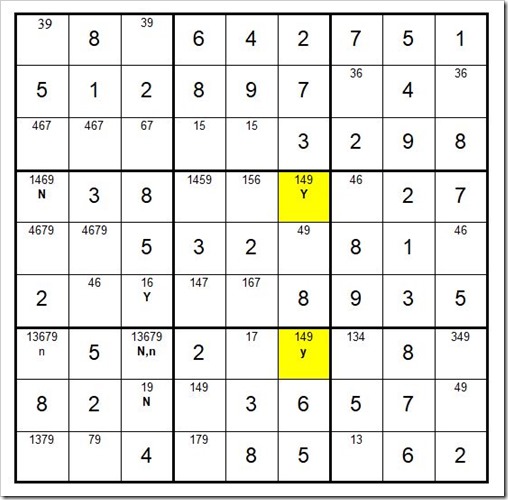
Example #32.4
|
We will continue with another Step 6 exercise.
In column 7 of Example #32.5 below we find just 2 unsolved cells that contain #4 as an option … C7R4 & C7R7. These cells are not in the same box, thereby qualifying as a candidate for a Step 6 exercise.
|
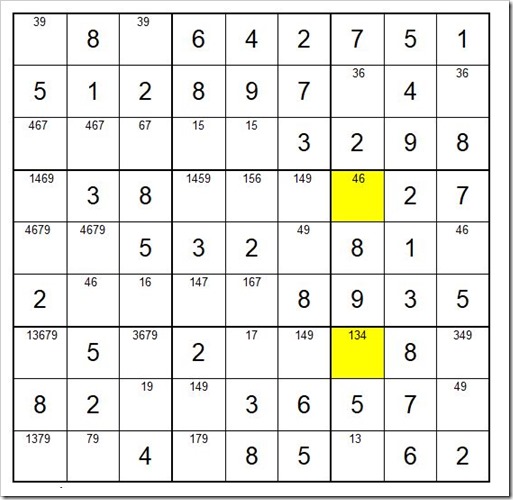
Example #32.5
|
One of these two yellow cells must be a 4. We will consider them as “driver cells” which “drive” the exercise.
Here is the logic. We will perform two exercises. First, we will assume C7R4 is the 4, and see which other cells cannot be a 4. Then we will assume C7R7 is the 4, and see which other cells cannot be a 4. What happens if we find a cell or cells that cannot be a 4 regardless of which cell in column 7 is a 4? Quite simply it means that that cell cannot be a 4 and you can eliminate the 4 from that cell or those cells.
We will mark C7R4 with a “Y” and mark C7R7 with a lower case “y” to keep track of the exercise as per Example #32.6 below.
If C7R4=4 (marked with a Y), then C6R4, C4R4 & C1R4 cannot be a 4 and we mark them below with a “N” for no.
If C7R7=4 (marked as a y), then C6R7 is not a 4 and we mark it with a n. The only other cell in box 8 that could be a 4 is C4R8 and we mark it with a y. Then C4R6 & C4R4 are not a 4 and we mark them with a n. Now look at C4R4 with its “N,n” designation. It is not a 4 regardless of which yellow cell is a 4. Therefore, you can remove a 4 as an option from C4R4.
|
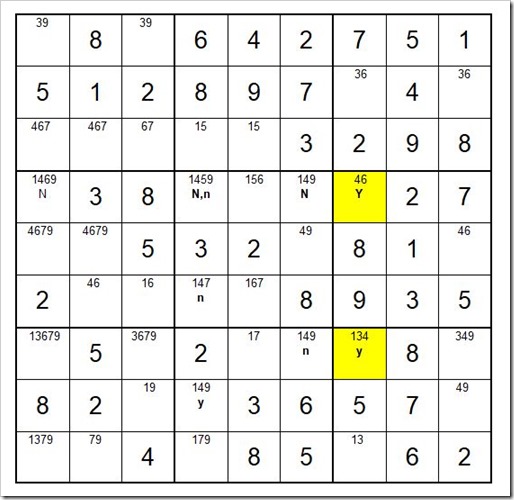
Example #32.6
|
Now your grid should look like Example #32.7 below:
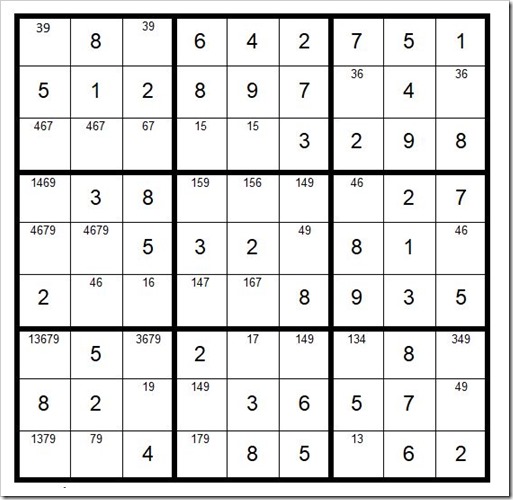
Example #32.7
|
Next, we will move on to Step 7.
STEP 7: DAN’S CLOSE RELATIONSHIP CHALLENGE
To begin this exercise, we choose any unsolved cell with just 2 options. We will choose C2R6 with options 46, which will be our “driver cell”. We will choose a sequence of 4,6 as indicated below in Example #32.8.
Logic: If C2R6=4, then we know that the adjacent cells cannot be a 4. We will indicate this by marking these cells with a “N4” per example below. If C2R6=6, then not all of the cells marked with a N4 can be a 4, therefore some of these cells are not a 4 regardless if C2R6 is a 4 or 6.
So we will track the 6 to see the outcome of the N4 cells. We will perform this track in the 3rd level of the unsolved cells. As we establish a value for a cell we will eliminate that option from the adjacent cells. To start C2R6=6. Right off we know that C3R6=1. Then C3R8=9. C3R1=3. C1R1=9. Then C1R4=4. C1R5=7 & C2R5=9 (highlighted in green).
We will pause here to see what we have learned. Logic: If C2R6=4, then C1R5 & C2R5 are not a 4. If C2R6=6, then C1R5=7 & C2R5=9. So regardless if C2R6 is a 4 or 6, C1R5 & C2R5 are not a 4. Since C2R6 has to be a 4 or 6, C1R5 & C2R5 cannot be a 4 and the 4 can be eliminated from these two cells.
|
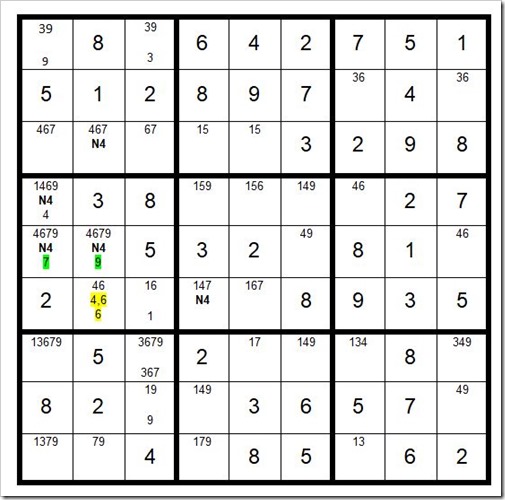
Example #32.8
|
Do we need to stop here? NO. Track the 6 further to see what happens. Example #32.9 below shows the tracking continued.
|
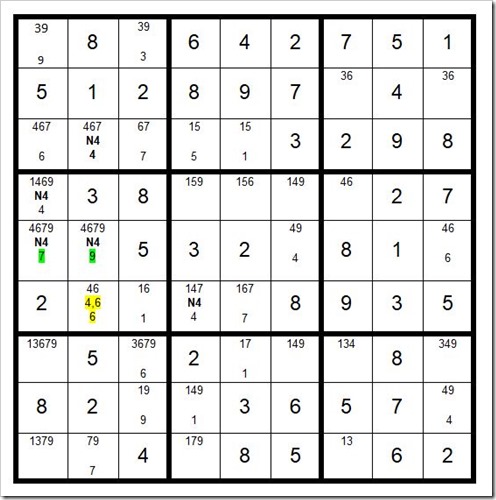
Example #32.9
|
Check out box 8 above in Example #32.9. Two cells have a 1 as their outcome of tracking the 6 in C2R6. This is a conflict! What does this mean? It means that C2R6 cannot be a 6. C2R6=4. Now your grid should look like Example #37.10 below:
|
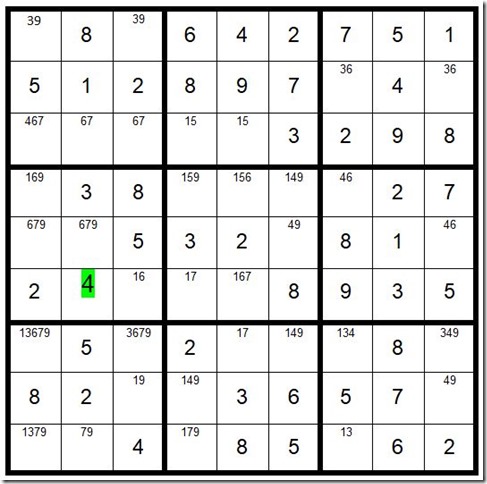
Example #32.10
|
The only cell in column 1 that can now be a 4 is C1R3. C1R3=4.
C6R4 & C6R5 form a Step 2 Interaction. One of those cells must be a 4; therefore, C6R7 cannot be a 4. Now C4R8 is the only cell in box 8 that can be a 4. C4R8=4.
From this point the puzzle is easily solved, giving you Example #32.11 below:
|
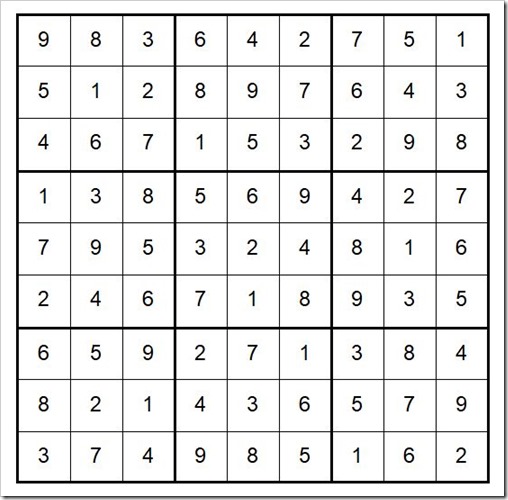
Example #32.11
|
Hope you enjoyed this puzzle. It was a good exercise of Steps 6 & 7.
May the gentle winds of Sudoku be at your back.
Editor’s note:
Do you tackle a Sudoku on your cottage veranda, sailboat cockpit, or at a campsite? TI Life is taking full advantage of Dan LeKander, from Wellesley Island, who is a Sudoku expert and author of “3 Advanced Sudoku Techniques – That Will Change Your Game Forever!”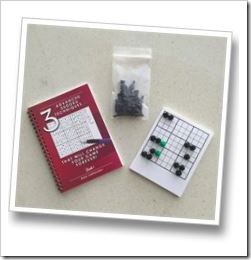
In January 2016, we published a final article in his series – but many of us enjoy using “Dan’s Steps,” so when he asked if we would like a puzzle to solve every month … this editor said an enthusiastic… Yes, please!
I suggest you try this relatively easy puzzle and that you also purchase Dan’s book, “3 Advanced Sudoku Techniques, That Will Change Your Game Forever!”
Most importantly, I ask that you leave comments on any part of his series and throughout the year. Remember when your teacher said – no such thing as a silly question – as we can all learn together.
Dan’s book is available online, amazon.com and on ebay.com.
Purchase of a book includes a 50-page blank grid pad, 33 black and two green tokens, to assist with Step 6.…
I want to thank Dan… what a lot of work he puts into our TI Life articles!
|
By Dan LeKander, Wellesley Island
Dan LeKander and his wife, Peggy, have been seasonal residents of Fineview, on Wellesley Island, NY, since 1983. In addition to being a Sudoku addict, Dan explores the 1000 Islands to enjoy the wildlife, beauty and of course, Catch-and Release bass fishing.
Editor’s Note: Wow; Number 31! How many have you completed?
[See Jessy Kahn’s Book Review, “3 Advanced Sudoku Techniques…” by Dan LeKander, June issue of TI Life.]